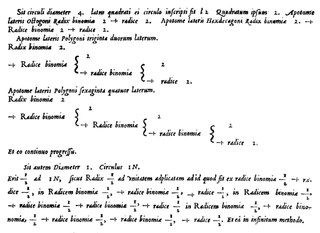Related Research Articles

Gottfried Wilhelm Leibniz was a German polymath active as a mathematician, philosopher, scientist and diplomat who invented calculus in addition to many other branches of mathematics and statistics. Leibniz has been called the "last universal genius" due to his knowledge and skills in different fields and because such people became less common during the Industrial Revolution and spread of specialized labor after his lifetime. He is a prominent figure in both the history of philosophy and the history of mathematics. He wrote works on philosophy, theology, ethics, politics, law, history, philology, games, music, and other studies. Leibniz also made major contributions to physics and technology, and anticipated notions that surfaced much later in probability theory, biology, medicine, geology, psychology, linguistics and computer science. In addition, he contributed to the field of library science by devising a cataloguing system whilst working at the Herzog August Library in Wolfenbüttel, Germany, that would have served as a guide for many of Europe's largest libraries. Leibniz's contributions to a wide range of subjects were scattered in various learned journals, in tens of thousands of letters and in unpublished manuscripts. He wrote in several languages, primarily in Latin, French and German.
The number π is a mathematical constant that is the ratio of a circle's circumference to its diameter, approximately equal to 3.14159. The number π appears in many formulae across mathematics and physics. It is an irrational number, meaning that it cannot be expressed exactly as a ratio of two integers, although fractions such as are commonly used to approximate it. Consequently, its decimal representation never ends, nor enters a permanently repeating pattern. It is a transcendental number, meaning that it cannot be a solution of an equation involving only finite sums, products, powers, and integers. The transcendence of π implies that it is impossible to solve the ancient challenge of squaring the circle with a compass and straightedge. The decimal digits of π appear to be randomly distributed, but no proof of this conjecture has been found.

Abraham de Moivre FRS was a French mathematician known for de Moivre's formula, a formula that links complex numbers and trigonometry, and for his work on the normal distribution and probability theory.
This article contains information about the literary events and publications of 1666.
John Machin was a professor of astronomy at Gresham College, London. He is best known for developing a quickly converging series for pi in 1706 and using it to compute pi to 100 decimal places.
The year 1766 in science and technology involved some significant events.
The year 1706 in science and technology involved some significant events.
The year 1695 in science and technology involved some significant events.
The year 1623 in science and technology involved some significant events.
The year 1666 in science and technology involved some significant events.

John Pell was an English mathematician and political agent abroad. He was made Royal Chair of Mathematics at Orange College by the Prince of Orange, and was under the patronage of Sir Charles Cavendish. He was also a compeer and correspondent of René Descartes and Thomas Hobbes.
In mathematics, the Leibniz formula for π, named after Gottfried Wilhelm Leibniz, states that

William Brouncker, 2nd Viscount Brouncker FRS was an Anglo-Irish peer and mathematician who served as the president of the Royal Society from 1662 to 1677. Best known for introducing Brouncker's formula, he also worked as a civil servant, serving as a commissioner in the Royal Navy. Brouncker was a friend and colleague of Samuel Pepys, and features prominently in the Pepys' diary.

In mathematics, Viète's formula is the following infinite product of nested radicals representing twice the reciprocal of the mathematical constant π:

The Kerala school of astronomy and mathematics or the Kerala school was a school of mathematics and astronomy founded by Madhava of Sangamagrama in Tirur, Malappuram, Kerala, India, which included among its members: Parameshvara, Neelakanta Somayaji, Jyeshtadeva, Achyuta Pisharati, Melpathur Narayana Bhattathiri and Achyuta Panikkar. The school flourished between the 14th and 16th centuries and its original discoveries seem to have ended with Narayana Bhattathiri (1559–1632). In attempting to solve astronomical problems, the Kerala school independently discovered a number of important mathematical concepts. Their most important results—series expansion for trigonometric functions—were described in Sanskrit verse in a book by Neelakanta called Tantrasangraha, and again in a commentary on this work, called Tantrasangraha-vakhya, of unknown authorship. The theorems were stated without proof, but proofs for the series for sine, cosine, and inverse tangent were provided a century later in the work Yuktibhasa, written in Malayalam, by Jyesthadeva, and also in a commentary on Tantrasangraha.
In mathematical logic, algebraic logic is the reasoning obtained by manipulating equations with free variables.
In mathematics, a Madhava series is one of the three Taylor series expansions for the sine, cosine, and arctangent functions discovered in 14th or 15th century in Kerala, India by the mathematician and astronomer Madhava of Sangamagrama or his followers in the Kerala school of astronomy and mathematics. Using modern notation, these series are:
Die Rechenmaschinen, by Ernst Martin, and its English translation, The Calculating Machines : Their History and Development, are books on mechanical desktop calculators from prior to World War II.
Descartes on Polyhedra: A Study of the "De solidorum elementis" is a book in the history of mathematics, concerning the work of René Descartes on polyhedra. Central to the book is the disputed priority for Euler's polyhedral formula between Leonhard Euler, who published an explicit version of the formula, and Descartes, whose De solidorum elementis includes a result from which the formula is easily derived.
References
- ↑ Roy, Ranjan (1990). "The Discovery of the Series Formula for π by Leibniz, Gregory and Nilakantha" (PDF). Mathematics Magazine . 63 (5): 291–306. doi:10.1080/0025570X.1990.11977541.
- ↑ Dickinson, H. W. (1970). Sir Samuel Morland: diplomat and inventor 1625-1695 . Cambridge: Heffer for the Newcomen Society. ISBN 0-85270-061-X.
- ↑ "Margaret Cavendish". The British Library. Retrieved 26 March 2019.